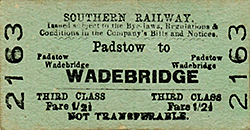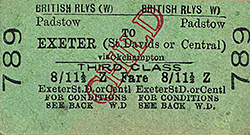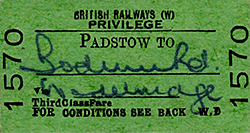|
  |
 |
 |
 |
old3.jpg)
Large crowds gather at Padstow station to greet the first official train on 27 March 1899. The vehicle nearest the camera is a 6-wheel 30ft full brake (aka luggage brake). Next to that, and also next to the loco, is what looks like a bogie gangwayed first. It has not been possible to identify the other coaches. The South Western (Metropolitan) Hotel, seen in the picture below, overlooking the station, has not yet been built.
Photo from John Mann collection
old4.jpg)
old19.jpg)
Photo from John Mann collection
old4.jpg)
A general view of the fish and locomotive facilities, such as they were, at Padstow and probably shortly after the line opened. The fish shed, centre background, is thought to have been erected after the line opened and is in its as-built condition. The turntable is the original 50ft example. Two points of interest are the luggage brake of the train at the platform and the grounded body in front of the fish shed. Both are oil lit. This involved a member of staff, lampman or porter, climbing onto the roof and inserting oil lamps into the cylindrical receptacles along the roof. It was for this reason that Victorian railway carriages were fitted with step-plates on their ends. Many oil-lit carriages survived the Grouping and did not finally disappear until circa 1930. General goods facilities were behind the passenger platform and out of view.
Copyright photo from John Alsop collection
Copyright photo from John Alsop collection
old19.jpg)
The delightfully, but not overwhelmingly, ornate station building at Padstow is seen from a refreshingly different viewpoint within a few years of opening. This view shows well how the station site was levelled out of the rock face overlooking the Camel estuary. On the left is the steep station approach road and behind it the South Western (Metropole) Hotel. The sidings disappearing into the background ended at buffer stops just around the corner. They did not, nor could they, continue round to North Quay. Part of the original fish shed can be seen on the right together with some LSWR rolling stock. The best-known LSWR coaching stock livery was brown and salmon, the latter colour having an orange hue which was probably not to everybody's liking. LSWR livery shades varied over the years according to the whims of successive chief mechanical engineers. Arguably such whims were a waste of money. Some fishing smacks can be seen in the estuary.
Photo
from Malcolm McCarthy collection
old121.jpg)
old121.jpg)
This unusual view over Padstow station is from St Saviour's (full title The Mission Church of St Saviour's) Trevone. The original church dated from 1894 and was replaced by a new structure in 1958. This is a very early view prior to the appearance of the railway jetty so pre-1910. Four of the wagons on the quay appear to be private owner examples but the letters, albeit quite bold, cannot be interpreted. On certain of the others, the lettering ‘LSWR’ can just be made out under magnification. Two passenger coaches are stabled at the end of the platform road while further such vehicles, plus at least one brake, are berthed at the fish shed, left of centre. Passenger vehicles berthed at the fish shed was a feature for almost the entire life of the railway at Padstow. The fish shed as seen here was in its original 1900 as-built form. It was later extended. Other features clearly visible are the station building, platform and canopy plus the lamp room and the goods shed. The small stone building on the right is a toilet. The original turntable can also just be discerned to the left of the fish shed. Dennis Hill and its obelisk can be seen in the background while on the left is Little Petherick Creek bridge. The distance from Padstow station by rail to the bridge was ¾mile. The children in the foreground are fascinated by the camera and this may well have been the first time they had been subjected to one. Sadly, today a photographer aiming a camera directly at children would probably cause swarms of police and a dazzle of blue lights to appear. Click here for a larger version.
Photo from Malcolm McCarthy collection
Photo from Malcolm McCarthy collection
old24.jpg)
Another period view of the station and fish shed, this time from a painting. However good artists were at the time, they did not always make a good job of trains and this scene is no exception. The apparently mixed train at the platform has more of the look of a Hornby 0 gauge clockwork train about it, yet care has been taken to depict a diamond headcode plate in front of the chimney.
Photo from Malcolm McCarthy collection
Photo from Malcolm McCarthy collection
old28.jpg)
An interesting, and somewhat rare for its detail, view of Padstow during LSWR days. The goods train consists of both open wagons and closed vans and is on one or other of the quayside lines to the north of the station. Displaying the distinctive Adams style cab, the locomotive is one of Adams' 460 class outside cylinder 4-4-0s and it can be identified as No.465 from the original batch built by Neilson & Co. in 1884. The photograph is pre-1912 for in that year she became No.0465. She survived until 1924. Part of the Metropole Hotel, originally the South Western Hotel, can be seen at far left. This was completed in 1904 so we can narrow down the date to the 1904 - 1912 period. Right of centre and at track level what was then the Fishermen’s Mission can be seen. Today the reference point for this site is the Padstow Memorial Hall. A little way beyond the Fishermen’s Mission stood the customs house. Today it is the Old Custom House hotel. Livery of the locomotive would appear to be LSWR lined green, a particularly attractive livery even by pre-grouping standards. The headcode is that for Exeter, at which location the train would probably be remarshalled and in all likelihood wagons would also be detached and attached along the way. The application of 'LSWR' to most if not all the wagons may seem an overkill but it should be remembered that goods vehicles, by the very nature of their work, could and did appear anywhere in the country irrespective of ownership so identification of owners was essential. The practice continued until nationalisation after which BR applied a regional prefix to numbers, but sometimes including 'BR' in small letters at the lower body sides. At least one of the open wagons appears to be what later came to be known as 'Hi-Bar' types; that coupled ahead of the first closed van. This open wagon has its tarpaulin in position. These wagons were used when the contents needed protecting from the weather. A variation of the type was the 'Clay Hoods' which were very familiar in Cornwall until relatively recent times. The unusual angle of this view is useful for giving an idea of how the railway at Padstow was constructed. The area occupied by the railway was once creek and at the lower level indicated, conveniently as the tide is out, by the mud at bottom right and the land was reclaimed. Off the picture to the left was once a timber pond, one of two, while the area occupied by the passenger station and to a point a little way north was once a shipbuilding dock. The western wall of this dock was retained to serve as a retaining wall on the west side of the station site; it can still be seen today. For clarity, the dock seen on the right predated the railway and was not affected by construction of the latter. For a visual indication of the location pre-railway, see the 1881 OS map. A grounded carriage body can be seen on the right with, behind it.
Copyright photo from John Alsop collection
old34.jpg)
Copyright photo from John Alsop collection
old34.jpg)
Staff pose proudly at Padstow behind LSWR 04 class No.636 in front of the fish shed. A large number of fish boxes are piled up alongside the train. A fish van train departed Padstow at 4.30 pm daily destined for Nine Elms. The shed is seen here as built; it was extended in 1933. The 04 class has an interesting history, being the only 0-4-2 type ever to bear LSWR livery and also a rare, for Britain, example of an 0-4-2 tender locomotive. They were also the first LSWR locomotives to carry cast brass number plates although No.636 appears to have retained painted numerals when photographed. The class was similar to the A12 class, the differences being not immediately obvious to the casual observer, which was introduced in 1887 and built at Nine Elms. Adams decided to expand the type with the result being a further sixty (the original batch comprised thirty) of which forty were built by Messrs Neilson & Co of Glasgow and these became the 04 class with No.636 being new in 1893. The decoration around the splashers was not painted but of polished brass. Dugald Drummond had taken over from William Adams as LSWR Locomotive Superintendent in 1895, becoming Chief Mechanical Engineer in 1904. It is said that Drummond, an apparently rather sour man, had the brass decoration removed as he viewed such things as unnecessary. Work such as this was usually done as locomotives passed through the workshops but, notwithstanding this, it does allow us to place an approximate date on the photograph of between 1899, when the Padstow branch opened, and 1905-7. The A12/04 class began to be withdrawn as early as 1928 with a trickle of withdrawals up to WWII when several were reprieved. Some were also used as air raid shelters by the simple expedient of parking them over the pits at engine sheds, as were a few of the LB&SCR D1 0-4-2Ts. Four of the 04 class just survived into BR ownership but never received BR numbers, one of them being No.636 which finally bowed out in October 1948. The final example was No.629 which went in December 1948. The vehicle couple behind No.636 appears to be a LSWR luggage van of a design introduced in 1894 but the reason for its inclusion in a goods train can only be guessed at. The route indicated by the locomotive headcode, which consists of two circular and one square plates, is not known. The square plates could be either plain white or white with a black cross but the photograph is not clear enough to determine which.
Photo
from Malcolm McCarthy collection
old27.jpg)
old27.jpg)
A further early twentieth century view of Padstow when, still showing the original layout except for the fish shed. A rake of typical period LSWR rolling stock is stabled on the turntable road due, presumably, to lack of siding space. Sidings were installed later between the platform roads and goods roads. The train at, or departing, the platform is headed by what looks like a Class 02 0-4-4T. It is displaying the headcode for Exeter.
Photo from Malcolm McCarthy collection
Photo from Malcolm McCarthy collection
old47.jpg)
Fish aplenty at Padstow circa early twentieth century. The name on the barrels is none too clear but looks like A Gould. The location is uncertain but the railway van plus what looks like the roof of a carriage in the background would suggest the fish shed and with the photographer having his back to the water. Of the two persons present, one is a fish worker and the other is a railway employee, Jack Tresidder. This view typifies the once-thriving British fishing industry and scenes such as this could be found at dozens of locations around the British coastline. For many small coastal towns and villages, not only in Cornwall, fishing was the community lifeline and what is left in respect of Cornwall mainly supplies local requirements and the tourist industry. Nationwide the industry still exists but on a much smaller scale with ports such as Fleetwood, to name just one, being virtually extinct as far as commercial fishing is concerned. Britain's largest fishing port today is probably Grimsby but even that has suffered decline since the so-called 'Cod Wars' and conservation issues centred upon supposedly declining fish stocks.
Photo from Malcolm McCarthy collection
Photo from Malcolm McCarthy collection
old101.jpg)
Fish workers at Padstow circa early twentieth century. The exact location is not easy to determine but is thought to be Pawlyn's premises located close to the locomotive turntable. This might be borne out by what is clearly the Pawlyn name on the barrel and what appears to be Padstow station in the right background. Note the lifebelt; the water would be to the immediate right of the photographer. Padstow is perhaps best known for landing pilchards (sardines) but other fish were landed including large quantities of herring. To the left is what looks like a large flatfish, perhaps a plaice or a lemon sole.
Photo from Malcolm McCarthy collection
old36.jpg)
old53.jpg)
Photo from Malcolm McCarthy collection
old36.jpg)
A none-too-perfect view of Padstow station and environs, believed from LSWR days. The worker on the track is carrying some sort of pot or bucket and, notwithstanding the fact he was no doubt undertaking regular maintenance work, a similar worker can be seen in other views so this view may date from the same time. There was no passenger train activity when this photograph was taken but plenty of rolling stock was present. Two rows of wagons sit on the tracks leading to the railway jetty while, on the left, a van sits on the loop siding which avoided the goods shed. Few photographs show this loop actually in use and it was removed in 1933.
Photo from Malcolm McCarthy collection
Photo from Malcolm McCarthy collection
old53.jpg)
Looking west across the Little Petherick Creek bridge in the first decade of the twentieth century. The train is headed by a small tank loco, most likely one of the Beattie well tanks, and the stock appears a mix of 4- and 6-wheelers. The vehicle at the rear of the train is an extremely ancient 4-wheel luggage brake and probably dating from circa 1860 if not earlier; it is lower and narrower than the rest of the train, thus quite typical of the mid nineteenth century.Photo
from Malcolm McCarthy collection
Click here for Padstow Gallery 3: Early 20th Century - 1914

|
| Last updated: Wednesday, 07-Mar-2018 14:50:27 CET | © 1998-2016 Disused Stations |

 Home Page
Home Page